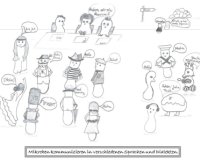
Microbes communicate with each other. Although we humans cannot hear this language, we can experience some of the effects of this communication: for example, some bacteria grow by "agreement" in protected cell clusters, biofilms, which we recognise as slimy coatings (on seals or in washing machine rinse chambers). Bacteria use small...









